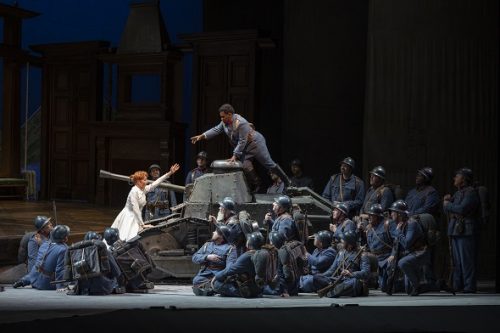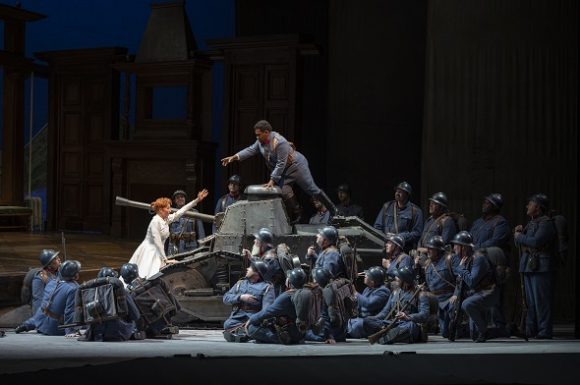 United States Donizetti, La fille du régiment: Soloists, Chorus and Orchestra of Lyric Opera of Chicago / Speranza Scappucci (conductor). Civic Opera House, Chicago, 25.11.2023. (JLZ)
United States Donizetti, La fille du régiment: Soloists, Chorus and Orchestra of Lyric Opera of Chicago / Speranza Scappucci (conductor). Civic Opera House, Chicago, 25.11.2023. (JLZ)

Production:
Original director & Costume designer – Laurent Pelly
Revival director – Christian Räth
Sets – Chantal Thomas
Lighting – Joël Adam
Dramaturg – Agathe Mélinand
Original choreographer – Laura Scozzi
Revival choreographer – Karine Girard
Chorus director – Michael Black
Cast:
Marie – Lisette Oropesa
Tonio – Lawrence Brownlee
Marquise – Ronnita Miller
Sulpice – Alessandro Corbelli
Hortensius – Alan Higgs
Corporal – Ron Dukes
Duchess of Crakentorp – Joy Hermalyn
Notary – Laureano Quant
Donizetti’s La fille du régiment (1840) has returned to Chicago in Laurent Pelly’s popular staging of the comic opera, with new dialogues by dramaturg Agathe Mélinand, a stellar cast and effective direction.
From the beginning of the overture, Speranza Scappucci demonstrated her mastery of the orchestra and set the tone for the evening with clearly delineated tempos that made the score vivid from start to finish. Some of the faster tempos were quite brisk, and nicely executed horn figuration added to the martial effects. With the slow tempos in the overture and elsewhere in the opera, Scappucci made the lingering sonorities richly intense as she brought out the colors in the scoring. While the brass are understandably prominent in a work with military music, the wood timbres added to the palette of sounds and increased the appeal.
As Marie, the titular daughter of the twenty-first regiment, Lisette Oropesa made the role her own with excellent delivery and natural acting that added to her character. Oropesa possesses the range, facility and technique for the role, and she built on those elements with timing and phrasing that reflected her sensitivity to the drama implicit in the text. The bravura elements that are part of many of the Act I numbers had welcome ease and clarity. The passages in the upper range fit well with her voice which is beautifully articulate in the middle and lower areas. Some of the most effective musicmaking on Oropesa’s part came in Act II, especially ‘Par le rang et par l’opulence’, where her characterization of Marie became more appealing. Here the transitions in the orchestra supported the return of martial music from Act I in the cabaletta that follows.

Lawrence Brownlee was an impeccable Tonio, a role that fits his talents exquisitely. Brownlee’s performance had the burnish of a master of the art, with his phrasing, tone and range making the part shimmer with musical and dramatic aplomb. It is rare to find a tenor with the facility to deliver the famous ‘Ah! mes amis, quel jour de fête’ with such style, and then to hear it reprised right after. The high notes emerged readily so that the audience could focus on the entire line, rather than hope for the high pitches not to break. Brownlee’s musicianship and style supported the technical demands in this and other numbers, a detail that is crucial for a showpiece role like this one.
The other characters were cast well, with Alessandro Corbelli effective as Sulpice. As with the other principals, the musical demands of the score were met with a fine sense of dramatic timing. Corbelli was as strong in this role in others, and I recalled his iconic appearance in Don Pasquale. Ronnita Miller was perfect as the Marquise, as she was in her memorable depiction of the very different character of Erda at Lyric several seasons ago. Miller showed her remarkable talent in her aria in the first scene, and her clear delivery extended to her low range, which she used to fine effect. Much of the second act drew on Miller’s acting, which worked well in presenting the revelation that set up the ‘lieto fine’ at the conclusion of the opera.
Part of the success here was due to the chorus, which performed with stylish precision. The men of the chorus worked together vocally and dramatically as they responded as a unit to the comic elements that are an essential part of Pelly’s production. Ryan Opera Center member Ron Dukes as the Corporal contributed some deft touches in his scenes with the army and was a solid presence on the stage.
As for the comic elements, the production is effective for its use of details associated with Marie, like the laundry, to bring out the timing of the famous duet with Sulpice in the first act. Yet some of the exchanges without music suffered from inconsistent amplification. In one scene, it sounded as if the body microphone for Sulpice was working while the one for Marie was not. Or this could have been a quirk of placement on the stage.
It is difficult to fault the blocking, which showed careful thought. That aside, some of the stagey elements in Act II were effective, like casting male dancers as maids at the beginning of the scene. Yet with straight dialogue, the pace of delivery was, perhaps, more appropriate to a smaller, more intimate theater than the large Civic Opera House. However, the space was effective in allowing the regiment to return in the final number with a tank commanded by Brownlee, a comic element that added to the overall effect of an outstanding La fille du régiment
James L. Zychowicz
